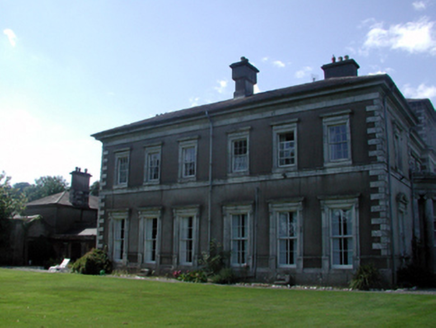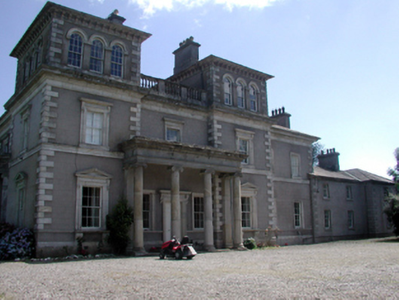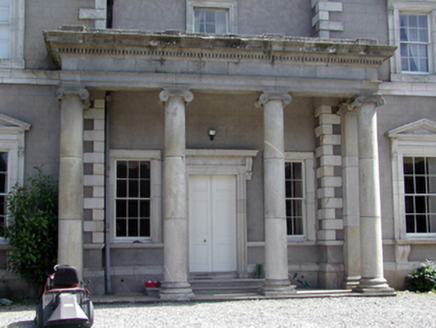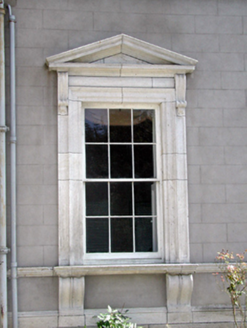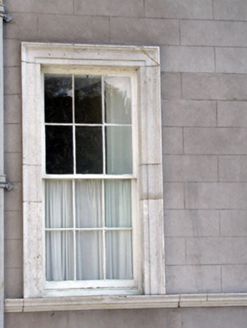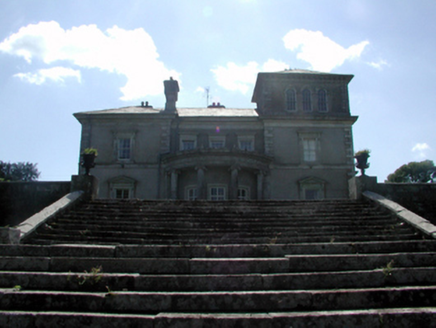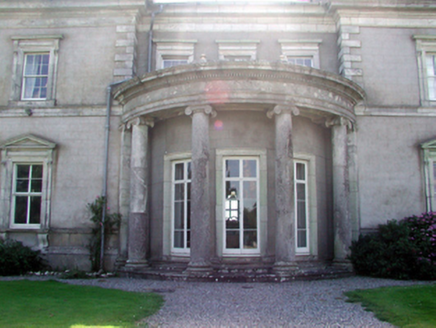Survey Data
Reg No
22901711
Rating
National
Categories of Special Interest
Architectural, Artistic, Historical, Social
Previous Name
Whitfield Court originally Whitfield
Original Use
House
In Use As
House
Date
1840 - 1845
Coordinates
253253, 108598
Date Recorded
14/08/2003
Date Updated
--/--/--
Description
Detached three-bay two--storey Italianate house, built 1841 - 1843, on a complex plan retaining original aspect comprising single-bay two-storey entrance bay with single-storey prostyle tetrastyle flat-roofed Ionic portico to ground floor, two-bay two-storey recessed flanking end bay to south-west, five-bay two-storey side/Garden (north-east) elevation with three-bay single-storey recessed central bay having single-bay single-storey shallow bow to ground floor with prostyle tetrastyle Ionic frontispiece, and six-bay two-storey rear (south-east) elevation. Renovated, c.1865, with single-bay single-storey blocks added to top floor to end bays of Entrance (north-west) Front forming single-bay three-stage engaged corner 'towers' on square plans. Hipped slate roofs (behind parapet to entrance bay; pyramidal to 'towers') with clay ridge tiles, rendered chimney stacks, and cast-iron rainwater goods on overhanging cut-stone eaves having consoles to 'towers'. Flat roofs to portico and to frontispiece not visible behind cornice parapet. Unpainted rendered, ruled and lined walls with cut-granite dressings including plinth, stringcourse to ground floor, quoins to corners, moulded stringcourse to first floor, frieze, and moulded cornice. Square-headed window openings with cut-stone sills forming sill courses (on consoles to ground floor), moulded cut-stone surrounds with some to ground floor having triangular and segmental pediments on consoles, and some to first floor having entablatures on pediments. 6/6 timber sash windows with 4/4 timber sash windows to ground floor rear (south-east) elevation. Grouped (three) round-headed window openings to top floor to 'towers' with cut-stone sills, moulded archivolts, and 6/6 timber sash windows. Square-headed door opening to entrance bay under cut-granite prostyle tetrastyle Ionic portico having entablature, frieze, moulded cornice, blocking course, moulded surround to door opening with entablature over on consoles, and timber panelled double doors. Square-headed door openings to bow to side/Garden (north-east) elevation behind cut-granite Ionic frontispiece having frieze and dentilated moulded cornice over, moulded surrounds, and glazed timber double doors with overlights. Interior with timber panelled shutters to window openings. Set back from road in own grounds with gravel forecourt, and landscaped grounds to site including terrace to north-east with flight of cut-stone steps. (ii) Attached three-bay two-storey lower service range, built 1841, to south-west retaining original aspect with single-bay two-storey advanced end bay to right (south-west). Pitched and hipped slate roofs with clay ridge tiles, rendered chimney stack, and cast-iron rainwater goods on rendered eaves. Unpainted rendered, ruled and lined walls with rendered quoins to ends, and to corners. Square-headed window openings with cut-stone sills, 3/6 and 6/6 timber sash windows.
Appraisal
A fine, well-appointed house built for William Christmas (n. d.) to designs prepared by Daniel Robertson (fl. 1820 - 1849), replacing an earlier house on site. The form and massing of the house as originally intended, including the incorporation of a service wing, recall Robertson's contemporary work at Ballinkeele (House), Ballymurn, in neighbouring County Wexford. A highly-detailed, Italianate house, the composition is distinguished by features including an elegant portico, and a graceful bow, both incorporating the Ionic Classical order, all of which enhance the architectural quality of the site. Additions by Abraham Denny (1820 - 1892) producing 'towers' that draw parallels with the architect’s scheme for Saint Catherine's Hall, Catherine Street/Waterside, Waterford (22504428/WD-5632-22-442), provide an elegant focal point to the Entrance (north-west) Front, yet are not successfully integrated when viewed from the north-east and south-west. Very well maintained, the house retains the original fabric, both to the exterior and to the interior, and remains an important element of the architectural heritage of the county.
